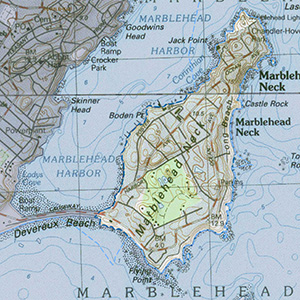Important Bird Area: Marblehead Neck
Site Summary
Nominated By
Jan Smith
Size
296 acres
Towns and Counties
Marblehead; Essex
Ownership
Mass Audubon, Town of Marblehead
Major Habitats
migratory stopover site 100%, urban/suburban 75%, oak-conifer forest 8%, marine/tidal 5%, coastal beach 2%; northern hardwood forest, cultural grassland, emergent freshwater wetland, salt marsh, lake/pond, river/stream <1%
Land Use
nature & wildlife, conservation/ land trust, utility right-of-way, suburban/residential
Serious Threats
non-native invasive plants, introduced animals, residential/commercial development, disturbance to birds or habitat
Minor Threats
predators, recreation overuse
IBA Criteria
- Category 1: Sites containing assemblages of species characteristic of a representative, rare, threatened, or unique habitat within the state or region.
- Category 4: Land Birds: The site is an important migratory stopover or seasonal concentration site for migratory land birds (e.g., warblers). Sites may also qualify on the basis of supporting exceptionally high densities of breeding species as shown from point counts or other surveys or if they represent "migrant traps" relative to surrounding areas. Strong consideration will be given to areas with consistently high overall species diversity.
Site Description
The IBA consists of a 17-acre Mass Audubon sanctuary, and two town-preserved rock outcrops. The majority of the remaining upland is privately owned large-lot residential developments. This site is a peninsula projecting northeast into Massachusetts Bay from the main peninsula of Marblehead and serves as a causeway for automobile traffic. The shoreline is rocky with several stretches of cobblestone beach. The upland is mostly residential developments with several "pocket" wetland and the Mass Audubon sanctuary. The historically open habitat of the upland portion of the peninsula has matured into forest and early successional shrubland.
Current Conservation Status
In the natural areas, invasive non-native plants (multiflora rose, European buckthorn, Tartarian honeysuckle, Norway maple, Japanese knotweed, and Oriental bittersweet) have steadily invaded the site over the past 40 years. Mass Audubon has done some invasive plant control efforts, girdling Norway maple and cutting back multiflora rose and Tartarian honeysuckle. Several volunteers are attempting to control Japanese knotweed. Due to the proximity of the residential area, feral pets and dogs frequent the site. Predators such as raccoons, foxes, and skunks are present in significant populations. Succession has closed the canopy of the Audubon sanctuary property, with forested lands increasing at the expense of open shrubby forest. No real efforts are being made to alter this succession, with the effect being that landfalls of migrant birds are being attracted increasingly to adjacent residential gardens. Disturbance is high due to extensive noise from residential activities (landscaping, construction, auto and truck traffic), as well as from airplanes overhead that originate at Logan International Airport.
Ornithological Significance
The site is a well-known coastal migrant trap, attracting large fallouts of migrants in both spring and fall when weather conditions are suitable. The natural areas provide stopover habitat for migrant birds. Among the >175 species annually recorded during migration at the site, there are two state endangered, one state threatened, and five state-listed species of special concern, and many regional high conservation priority species. Fallout numbers of land birds often number in the thousands of individuals.
Other Flora or Fauna of Significance
None known.
Data Sources
Source data for high conservation priority species estimates based on Bird Observer, 1991 records, and personal observation.




